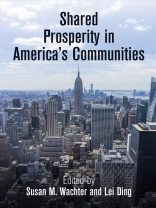While the nation’s GDP has doubled in the last thirty years, significant increases in family income have been restricted to a small subset of the American population. This disjunct between national economic growth and stagnating incomes in all but the very top tier of the population corresponds with increasing economic inequality and a lack of social and economic mobility. As a consequence, neighborhoods and metropolitan areas have become more polarized. Stark geographic differences in levels of poverty, income, health outcomes, job opportunities, lifetime earning potential, and educational attainment highlight the degree to which place matters in terms of social and economic opportunity.
Shared Prosperity in America’s Communities examines this place-based disparity of opportunity and suggests what can be done to ensure that the benefits of economic growth are widely shared. Contributors’ essays explore social and economic mobility throughout the country to illuminate the changing geography of inequality, offer a portfolio of strategies to address the challenges of place-based inequality, and show how communities across the nation are implementing change and building a future of shared prosperity. Approaching the problem from the vantage point of economics, sociology, and public policy, Shared Prosperity in America’s Communities offers a timely analysis of the country’s growing socioeconomic and geographic division and shows how communities can respond to the challenge of economic inequality to build a nation of opportunity for all.
Contributors: J. Cameron Anglum, Timothy J. Bartik, Chris Benner, Angela Glover Blackwell, Anthony P. Carnevale, Raj Chetty, Rebecca Diamond, Lei Ding, Paul A. Jargowsky, David N. Karp, Elizabeth Kneebone, Douglas S. Massey, Jeremy Nowak, Manuel Pastor, Victor Rubin, Chris Schildt, Nicole Smith, Margery Austin Turner, Susan M. Wachter, Zachary D. Wood.
قائمة المحتويات
Introduction
PART I. SOCIAL AND ECONOMIC MOBILITY IN AMERICA’S COMMUNITIES
Chapter 1. Socioeconomic Mobility in the United States: New Evidence and Policy Lessons
—Raj Chetty
Chapter 2. Neighborhoods and Segregation
—Paul A. Jargowsky
Chapter 3. The Changing Geography of Disadvantage
—Elizabeth Kneebone
Chapter 4. U.S. Workers’ Diverging Locations: Causes and Inequality Consequences
—Rebecca Diamond
PART II. HOW TO ENCOURAGE GROWTH AND EXPAND OPPORTUNITY
Chapter 5. Building Shared Prosperity Through Place-Conscious Strategies That Reweave the Goals of Fair Housing and Community Development
—Margery Austin Turner
Chapter 6. Confronting the Legacy of American Apartheid
—Douglas S. Massey
Chapter 7. Expanding Educational Opportunity in Urban School Districts
—Paul A. Jargowsky, Zachary D. Wood, J. Cameron Anglum, and David N. Karp
Chapter 8. Preparing Today’s Youth for Tomorrow’s Jobs
—Anthony P. Carnevale and Nicole Smith
Chapter 9. Labor-Demand-Side Economic Development Incentives and Urban Opportunity
—Timothy J. Bartik
PART III. SHARED PROSPERITY: PERSPECTIVES ON EQUITABLE AND INCLUSIVE GROWTH
Chapter 10. Equitable and Inclusive Growth Strategies for American Cities
—Victor Rubin, Angela Glover Blackwell, and Chris Schildt
Chapter 11. The Fragility of Growth in a Post-Industrial City
—Jeremy Nowak
Chapter 12. Fostering an Inclusive Metropolis: Equity, Growth, and Community
—Chris Benner and Manuel Pastor
Notes
References
List of Contributors
Index
Acknowledgments
عن المؤلف
Susan M. Wachter is the Albert Sussman Professor of Real Estate and Professor of Finance, The Wharton School; Professor of City and Regional Planning, School of Design; and Co-Director, Penn Institute for Urban Research, at the University of Pennsylvania. Lei Ding is Community Development Economic Advisor at the Federal Reserve Bank of Philadelphia.












